Ke Cheng
P/D-Device: Disaggregated Large Language Model between Cloud and Devices
Aug 12, 2025Abstract:Serving disaggregated large language models has been widely adopted in industrial practice for enhanced performance. However, too many tokens generated in decoding phase, i.e., occupying the resources for a long time, essentially hamper the cloud from achieving a higher throughput. Meanwhile, due to limited on-device resources, the time to first token (TTFT), i.e., the latency of prefill phase, increases dramatically with the growth on prompt length. In order to concur with such a bottleneck on resources, i.e., long occupation in cloud and limited on-device computing capacity, we propose to separate large language model between cloud and devices. That is, the cloud helps a portion of the content for each device, only in its prefill phase. Specifically, after receiving the first token from the cloud, decoupling with its own prefill, the device responds to the user immediately for a lower TTFT. Then, the following tokens from cloud are presented via a speed controller for smoothed TPOT (the time per output token), until the device catches up with the progress. On-device prefill is then amortized using received tokens while the resource usage in cloud is controlled. Moreover, during cloud prefill, the prompt can be refined, using those intermediate data already generated, to further speed up on-device inference. We implement such a scheme P/D-Device, and confirm its superiority over other alternatives. We further propose an algorithm to decide the best settings. Real-trace experiments show that TTFT decreases at least 60%, maximum TPOT is about tens of milliseconds, and cloud throughput increases by up to 15x.
CAKE: Cascading and Adaptive KV Cache Eviction with Layer Preferences
Mar 16, 2025



Abstract:Large language models (LLMs) excel at processing long sequences, boosting demand for key-value (KV) caching. While recent efforts to evict KV cache have alleviated the inference burden, they often fail to allocate resources rationally across layers with different attention patterns. In this paper, we introduce Cascading and Adaptive KV cache Eviction (CAKE), a novel approach that frames KV cache eviction as a "cake-slicing problem." CAKE assesses layer-specific preferences by considering attention dynamics in both spatial and temporal dimensions, allocates rational cache size for layers accordingly, and manages memory constraints in a cascading manner. This approach enables a global view of cache allocation, adaptively distributing resources across diverse attention mechanisms while maintaining memory budgets. CAKE also employs a new eviction indicator that considers the shifting importance of tokens over time, addressing limitations in existing methods that overlook temporal dynamics. Comprehensive experiments on LongBench and NeedleBench show that CAKE maintains model performance with only 3.2% of the KV cache and consistently outperforms current baselines across various models and memory constraints, particularly in low-memory settings. Additionally, CAKE achieves over 10x speedup in decoding latency compared to full cache when processing contexts of 128K tokens with FlashAttention-2. Our code is available at https://github.com/antgroup/cakekv.
FairKV: Balancing Per-Head KV Cache for Fast Multi-GPU Inference
Feb 19, 2025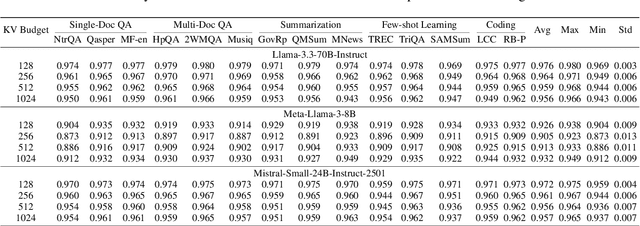
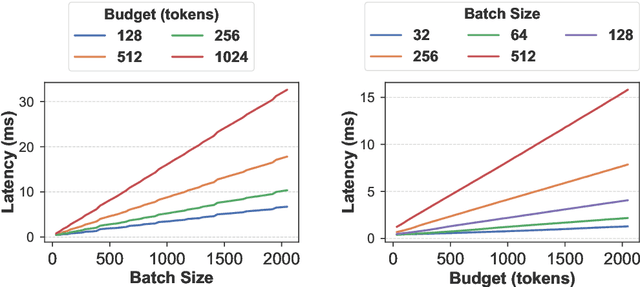
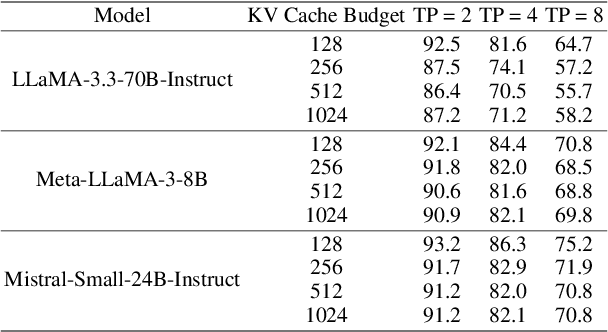
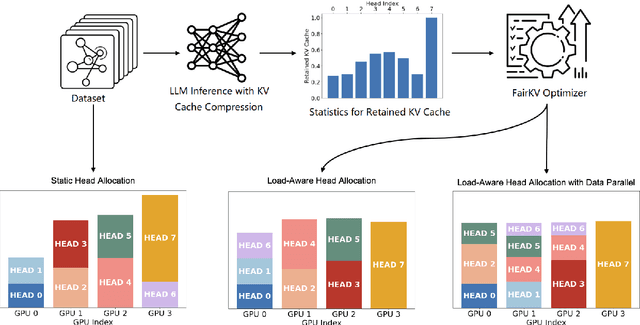
Abstract:KV cache techniques in Transformer models aim to reduce redundant computations at the expense of substantially increased memory usage, making KV cache compression an important and popular research topic. Recently, state-of-the-art KV cache compression methods implement imbalanced, per-head allocation algorithms that dynamically adjust the KV cache budget for each attention head, achieving excellent performance in single-GPU scenarios. However, we observe that such imbalanced compression leads to significant load imbalance when deploying multi-GPU inference, as some GPUs become overburdened while others remain underutilized. In this paper, we propose FairKV, a method designed to ensure fair memory usage among attention heads in systems employing imbalanced KV cache compression. The core technique of FairKV is Fair-Copying, which replicates a small subset of memory-intensive attention heads across GPUs using data parallelism to mitigate load imbalance. Our experiments on popular models, including LLaMA 70b and Mistral 24b model, demonstrate that FairKV increases throughput by 1.66x compared to standard tensor parallelism inference. Our code will be released as open source upon acceptance.
DrivingDojo Dataset: Advancing Interactive and Knowledge-Enriched Driving World Model
Oct 14, 2024
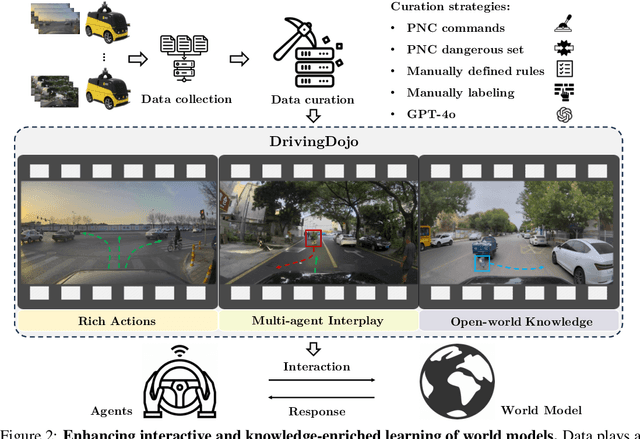

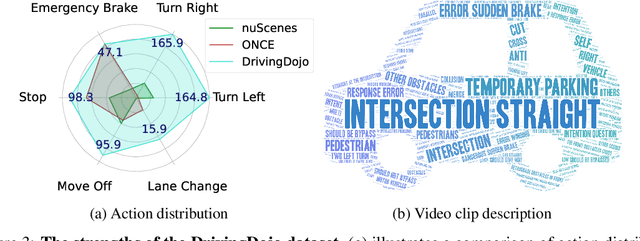
Abstract:Driving world models have gained increasing attention due to their ability to model complex physical dynamics. However, their superb modeling capability is yet to be fully unleashed due to the limited video diversity in current driving datasets. We introduce DrivingDojo, the first dataset tailor-made for training interactive world models with complex driving dynamics. Our dataset features video clips with a complete set of driving maneuvers, diverse multi-agent interplay, and rich open-world driving knowledge, laying a stepping stone for future world model development. We further define an action instruction following (AIF) benchmark for world models and demonstrate the superiority of the proposed dataset for generating action-controlled future predictions.
DyGKT: Dynamic Graph Learning for Knowledge Tracing
Jul 30, 2024



Abstract:Knowledge Tracing aims to assess student learning states by predicting their performance in answering questions. Different from the existing research which utilizes fixed-length learning sequence to obtain the student states and regards KT as a static problem, this work is motivated by three dynamical characteristics: 1) The scales of students answering records are constantly growing; 2) The semantics of time intervals between the records vary; 3) The relationships between students, questions and concepts are evolving. The three dynamical characteristics above contain the great potential to revolutionize the existing knowledge tracing methods. Along this line, we propose a Dynamic Graph-based Knowledge Tracing model, namely DyGKT. In particular, a continuous-time dynamic question-answering graph for knowledge tracing is constructed to deal with the infinitely growing answering behaviors, and it is worth mentioning that it is the first time dynamic graph learning technology is used in this field. Then, a dual time encoder is proposed to capture long-term and short-term semantics among the different time intervals. Finally, a multiset indicator is utilized to model the evolving relationships between students, questions, and concepts via the graph structural feature. Numerous experiments are conducted on five real-world datasets, and the results demonstrate the superiority of our model. All the used resources are publicly available at https://github.com/PengLinzhi/DyGKT.
Co-Neighbor Encoding Schema: A Light-cost Structure Encoding Method for Dynamic Link Prediction
Jul 30, 2024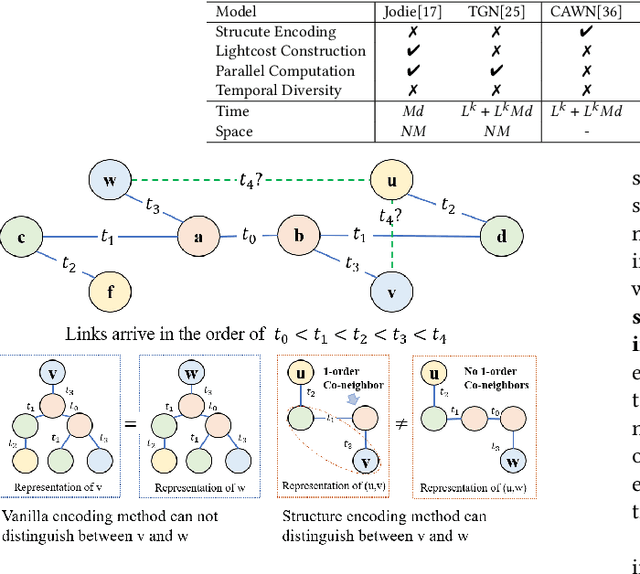
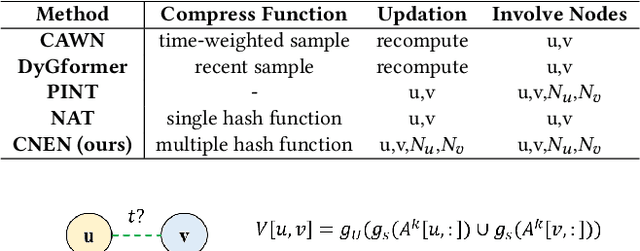
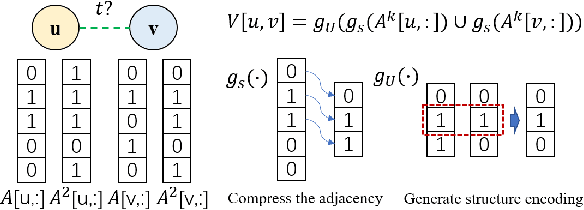
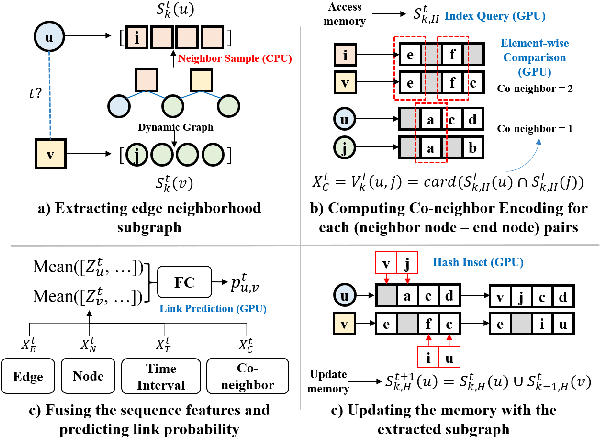
Abstract:Structure encoding has proven to be the key feature to distinguishing links in a graph. However, Structure encoding in the temporal graph keeps changing as the graph evolves, repeatedly computing such features can be time-consuming due to the high-order subgraph construction. We develop the Co-Neighbor Encoding Schema (CNES) to address this issue. Instead of recomputing the feature by the link, CNES stores information in the memory to avoid redundant calculations. Besides, unlike the existing memory-based dynamic graph learning method that stores node hidden states, we introduce a hashtable-based memory to compress the adjacency matrix for efficient structure feature construction and updating with vector computation in parallel. Furthermore, CNES introduces a Temporal-Diverse Memory to generate long-term and short-term structure encoding for neighbors with different structural information. A dynamic graph learning framework, Co-Neighbor Encoding Network (CNE-N), is proposed using the aforementioned techniques. Extensive experiments on thirteen public datasets verify the effectiveness and efficiency of the proposed method.
Multi-scale Semantic Correlation Mining for Visible-Infrared Person Re-Identification
Nov 24, 2023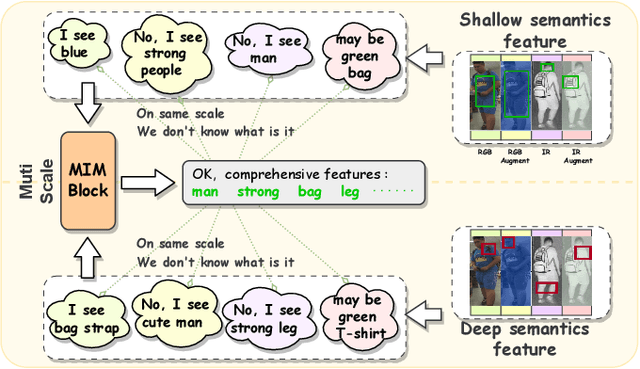
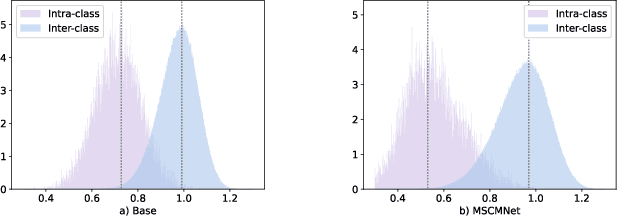
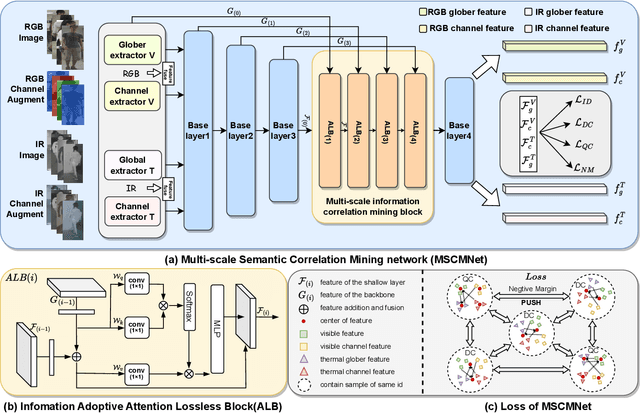
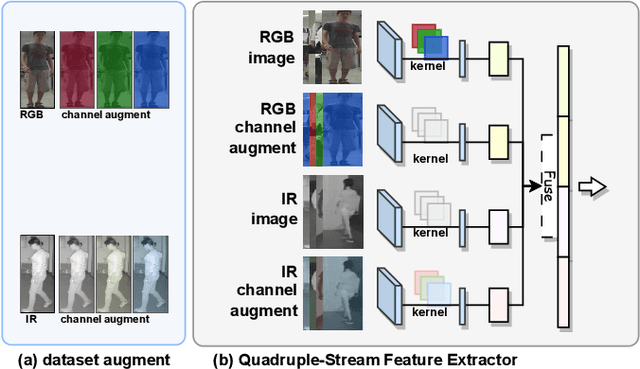
Abstract:The main challenge in the Visible-Infrared Person Re-Identification (VI-ReID) task lies in how to extract discriminative features from different modalities for matching purposes. While the existing well works primarily focus on minimizing the modal discrepancies, the modality information can not thoroughly be leveraged. To solve this problem, a Multi-scale Semantic Correlation Mining network (MSCMNet) is proposed to comprehensively exploit semantic features at multiple scales and simultaneously reduce modality information loss as small as possible in feature extraction. The proposed network contains three novel components. Firstly, after taking into account the effective utilization of modality information, the Multi-scale Information Correlation Mining Block (MIMB) is designed to explore semantic correlations across multiple scales. Secondly, in order to enrich the semantic information that MIMB can utilize, a quadruple-stream feature extractor (QFE) with non-shared parameters is specifically designed to extract information from different dimensions of the dataset. Finally, the Quadruple Center Triplet Loss (QCT) is further proposed to address the information discrepancy in the comprehensive features. Extensive experiments on the SYSU-MM01, RegDB, and LLCM datasets demonstrate that the proposed MSCMNet achieves the greatest accuracy.
SMAP: A Novel Heterogeneous Information Framework for Scenario-based Optimal Model Assignment
May 23, 2023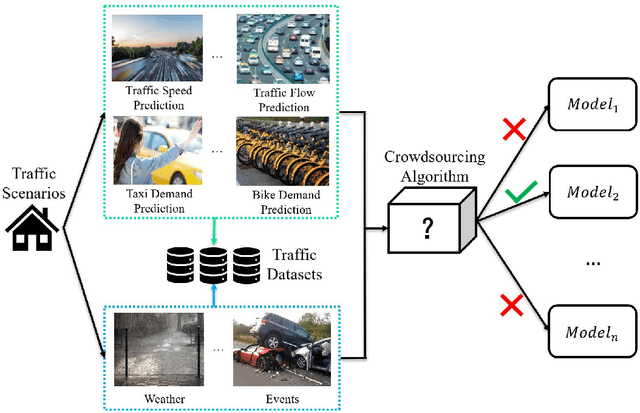
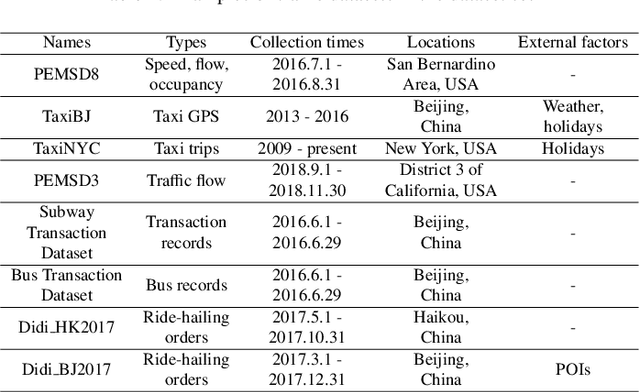
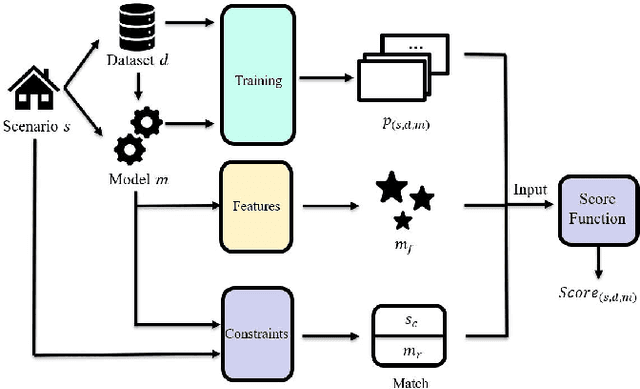
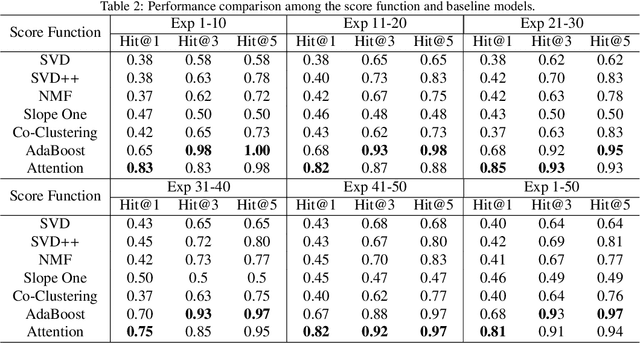
Abstract:The increasing maturity of big data applications has led to a proliferation of models targeting the same objectives within the same scenarios and datasets. However, selecting the most suitable model that considers model's features while taking specific requirements and constraints into account still poses a significant challenge. Existing methods have focused on worker-task assignments based on crowdsourcing, they neglect the scenario-dataset-model assignment problem. To address this challenge, a new problem named the Scenario-based Optimal Model Assignment (SOMA) problem is introduced and a novel framework entitled Scenario and Model Associative percepts (SMAP) is developed. SMAP is a heterogeneous information framework that can integrate various types of information to intelligently select a suitable dataset and allocate the optimal model for a specific scenario. To comprehensively evaluate models, a new score function that utilizes multi-head attention mechanisms is proposed. Moreover, a novel memory mechanism named the mnemonic center is developed to store the matched heterogeneous information and prevent duplicate matching. Six popular traffic scenarios are selected as study cases and extensive experiments are conducted on a dataset to verify the effectiveness and efficiency of SMAP and the score function.
PKD: General Distillation Framework for Object Detectors via Pearson Correlation Coefficient
Jul 05, 2022
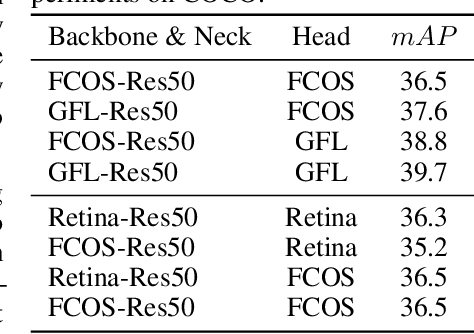
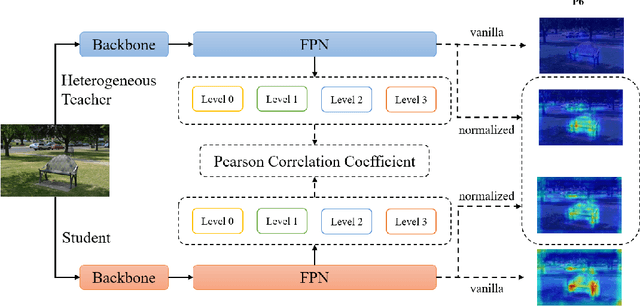
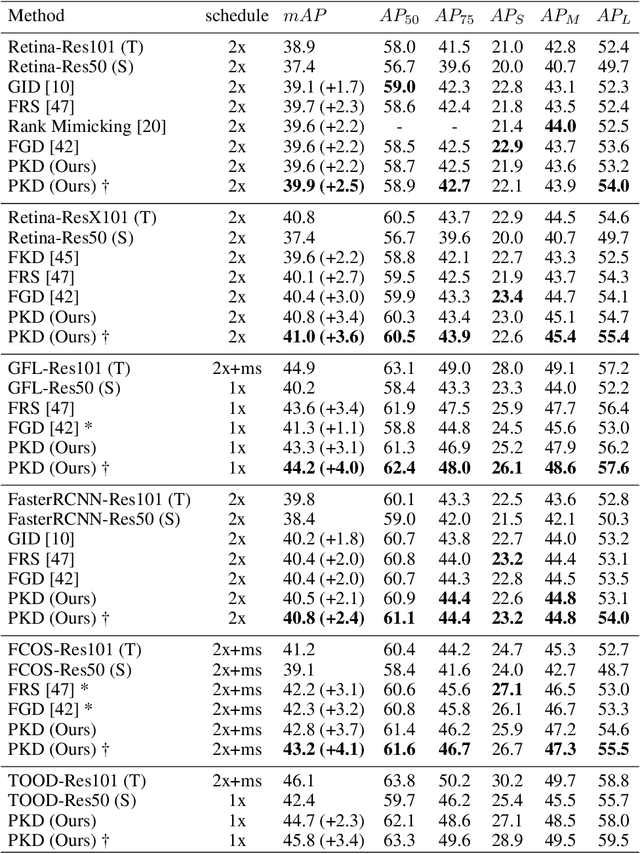
Abstract:Knowledge distillation(KD) is a widely-used technique to train compact models in object detection. However, there is still a lack of study on how to distill between heterogeneous detectors. In this paper, we empirically find that better FPN features from a heterogeneous teacher detector can help the student although their detection heads and label assignments are different. However, directly aligning the feature maps to distill detectors suffers from two problems. First, the difference in feature magnitude between the teacher and the student could enforce overly strict constraints on the student. Second, the FPN stages and channels with large feature magnitude from the teacher model could dominate the gradient of distillation loss, which will overwhelm the effects of other features in KD and introduce much noise. To address the above issues, we propose to imitate features with Pearson Correlation Coefficient to focus on the relational information from the teacher and relax constraints on the magnitude of the features. Our method consistently outperforms the existing detection KD methods and works for both homogeneous and heterogeneous student-teacher pairs. Furthermore, it converges faster. With a powerful MaskRCNN-Swin detector as the teacher, ResNet-50 based RetinaNet and FCOS achieve 41.5% and 43.9% mAP on COCO2017, which are 4.1\% and 4.8\% higher than the baseline, respectively.
FedProc: Prototypical Contrastive Federated Learning on Non-IID data
Sep 25, 2021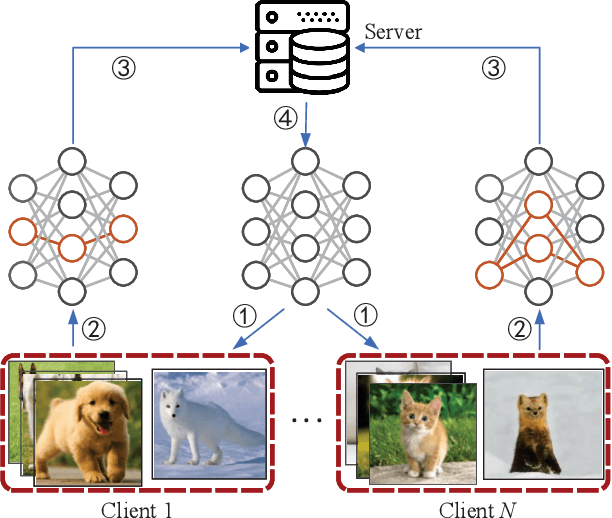
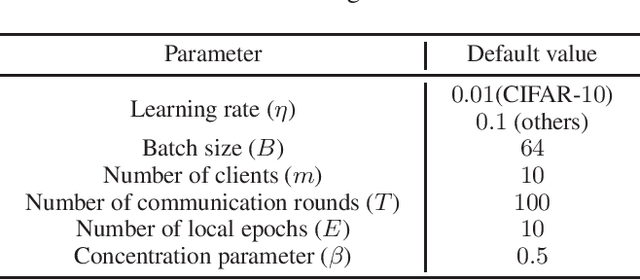

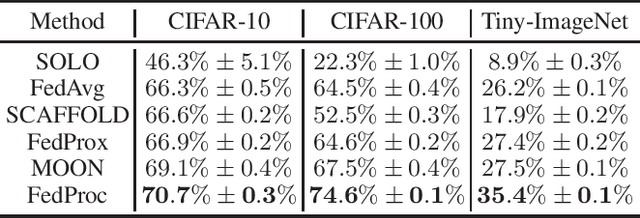
Abstract:Federated learning allows multiple clients to collaborate to train high-performance deep learning models while keeping the training data locally. However, when the local data of all clients are not independent and identically distributed (i.e., non-IID), it is challenging to implement this form of efficient collaborative learning. Although significant efforts have been dedicated to addressing this challenge, the effect on the image classification task is still not satisfactory. In this paper, we propose FedProc: prototypical contrastive federated learning, which is a simple and effective federated learning framework. The key idea is to utilize the prototypes as global knowledge to correct the local training of each client. We design a local network architecture and a global prototypical contrastive loss to regulate the training of local models, which makes local objectives consistent with the global optima. Eventually, the converged global model obtains a good performance on non-IID data. Experimental results show that, compared to state-of-the-art federated learning methods, FedProc improves the accuracy by $1.6\%\sim7.9\%$ with acceptable computation cost.
 Add to Chrome
Add to Chrome Add to Firefox
Add to Firefox Add to Edge
Add to Edge